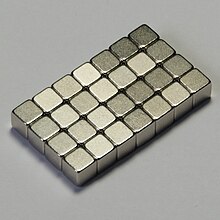Rare earth magnet
The name rare earth magnets (also known as rare earth magnets ) is a group of permanent magnets consisting essentially of ferrous metals ( iron , cobalt , less often nickel ) and rare earth metals (especially neodymium , samarium , praseodymium , dysprosium , terbium , gadolinium ) . Also yttrium can assume the role of a rare earth metal. They are distinguished by the fact that they simultaneously have a high magnetic remanence flux density B r and a high magnetic coercive field strength H c and thus a high magnetic energy density.
The first rare earth magnets were developed by Karl J. Strnat and G. Hoffer at the US Air Force Materials Laboratory at Wright-Patterson Air Force Base with the two basic materials yttrium and cobalt in the form YCo 5 . In 1966 Karl J. Strnat developed the alloy Samarium-Cobalt SmCo 5 . Neodymium-iron-boron magnets were developed by Masato Sagawa in the 1980s .
Intermetallic compounds
The most important intermetallic compounds are the inexpensive neodymium iron boron (Nd 2 Fe 14 B) and samarium cobalt (SmCo 5 and Sm 2 Co 17 ). In addition, is also samarium-iron-nitrogen (Sm 2 Fe 18 N 3 ) used commercially. The following table summarizes some rare earth magnet materials and, for the purpose of comparison, other magnet materials:
| material |
Remanent flux density B r (T) |
Coercive field strength H ci (kA / m) |
Energy density (BH) max (kJ / m 3 ) |
Curie temperature T c (° C) |
|---|---|---|---|---|
|
Neodymium-iron-boron (anisotropic, sintered) Nd 2 Fe 14 B |
1.0 -1.4 | 750-2000 | 200-440 | 310-400 |
| Neodymium-iron-boron (isotropic, usually plastic-bound) Nd 2 Fe 14 B |
0.6 -0.8 | 600-1200 | 60-100 | 310-400 |
|
Samarium-Cobalt (anisotropic, sintered) SmCo 5 (sintered) |
0.9 -1.1 | 600-2000 | 120-200 | 720 |
| Sm 2 (Co, Fe, Cu, Zr) 17 (anisotropic, sintered) | 1.1 -1.15 | 450-1300 | 150-240 | 800 |
| In comparison, the magnets AlNiCo (group of steel magnets) and strontium ferrite from the group of ceramic magnets: | ||||
| Alnico (anisotropic) | 0.6 -1.4 | 60- 275 | 10- 88 | 700-860 |
| Sr ferrites (anisotropic) | 0.35-0.4 | 100- 300 | 10- 40 | 450 |
In addition, a variety of permanent magnetic alloys with a similar composition have been scientifically investigated, but which have poorer properties and have therefore remained technically uninteresting.
The base alloys are varied to achieve special properties and structures - for example by partially replacing neodymium in Nd 2 Fe 14 B with praseodymium, dysprosium, terbium and iron partly with cobalt - or by adding foreign atoms such as aluminum , titanium , zirconium , Copper or manganese is disturbed. Finally, Nd 2 Fe 14 B needs an enrichment of rare earths between the crystals in order to achieve an acceptable coercive field strength.
Mode of action
The rare earths ( lanthanoids ) are already ferromagnetic in themselves , but their Curie temperatures are below room temperature, so that when they are present in elemental form their magnetism can only be observed at low temperatures. The atoms of the rare earth elements have high magnetic moments . This is a consequence of the incomplete filling of the 4f shell , which consists of up to seven unpaired electrons with aligned spins. Electrons in such orbitals are strongly localized and therefore easily retain their magnetic moments and function as paramagnetic centers. Magnetic moments in other orbitals are often lost due to the strong overlap with the neighbors, e.g. B. Electrons in covalent bonds form pairs with zero net spin.
The magnetic polarization of the rare earth magnets is based essentially on the spins of the 3d shells of the ferrous metals. The rare earth metals stabilize the magnetic alignment of the 3d shells because their crystalline structures have a very high magnetic anisotropy . This means that a crystal made of the material is magnetized in one direction, but refuses to be magnetized in another direction.
The high magnetic moments at the atomic level combined with a stable alignment, i.e. H. a high magnetic anisotropy result in a high magnetic coercive field strength on a macroscopic level.
literature
- Peter Campbell: Permanent Magnet Materials and their Application . Cambridge University Press, 1996, ISBN 978-0-521-56688-9 .
Individual evidence
- ↑ BD Cullity, CD Graham: Introduction to Magnetic Materials . 2nd Edition. Wiley-IEEE Press, 2008, ISBN 978-0-471-47741-9 , pp. 489 .
- ↑ History of Rare-Earth Magnets. Retrieved May 29, 2013 .
- ↑ Standard Specifications for Permanent Magnet Materials (PDF; 1.4 MB), MMPA Standard No. 0100-00, 2000
